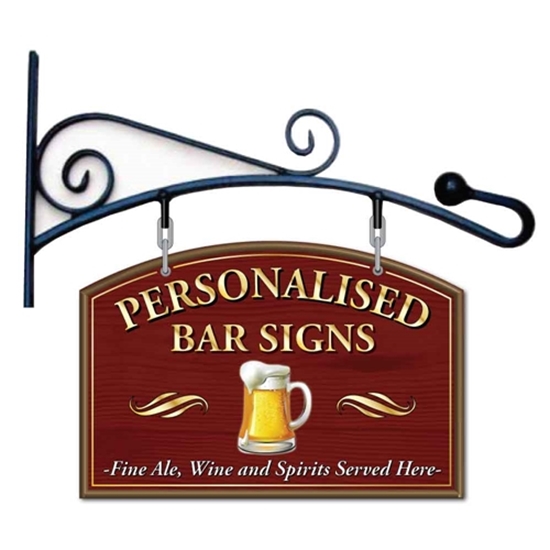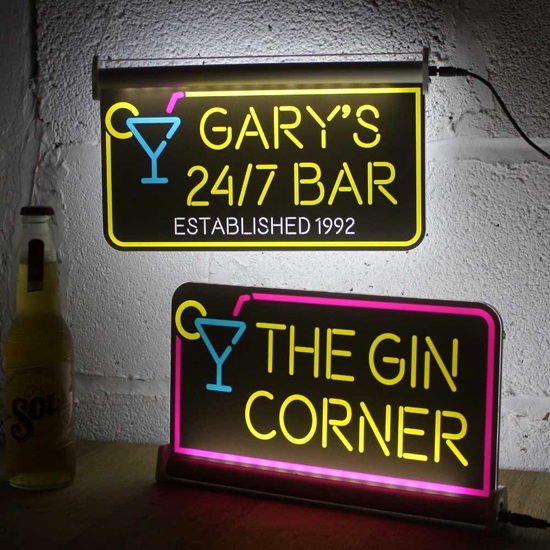Free Reasons On Choosing Bar Runners
Wiki Article
What Is The Difference Between Bar Signs From One Another In Relation To Their Intended Purpose?
Bar signs may differ greatly in terms of function. The reason for bar signs differs for each. Branding
The purpose is to establish and strengthen the branding of the bar.
Typically, the logo of the bar is included, its name, or its signature colors. It is designed to be an imposing element that reflects the overall theme and vibe of the bar.
For instance neon signs that have the bar's logo, or metal signs that feature the bar's name.
2. Information
Use: Provide vital details to patrons on the bar.
Features: Clear text with clear information on the hours of operation, WiFI passwords, home rules or bathroom areas.
Examples: Wall-mounted signs at the entrance, with the hours of operation, or signs that point to restrooms.
3. The Decorated
Goal : To improve the appearance and atmosphere of the bar.
Features: They are often aesthetic or thematic, and contribute to the look of the entire bar. Specific information or text could not be included.
Examples: Vintage advertisements for beer, signs that have a humor or a humorous tone or themed artwork.
4. Promo Coupons
Purpose : To promote an event, product or other particular.
Features: Designs that are eye-catching and highlight upcoming events, specials or new menu items. Can include temporary elements or changeable elements.
Examples: chalkboards that list daily specials; banners that promote Happy Hour deals; posters for upcoming event.
5. Directional
The goal of the guide is to guide patrons to the bar.
Specifications: Clear directions or arrows to guide customers to the right areas, such as the bathroom, exits, or to the various locations in the bar.
Examples: Directional arrows for different seating areas, signs that point toward restrooms and exits.
6. Regulatory/Compliance
The purpose of this program is to ensure compliance with safety and legal standards.
Features: Necessary signs that meet legal requirements for example, indicating smoking areas, maximum occupancy limits and emergency exits.
Signs that prohibit smoking, limit occupancy or warn of emergency exits are examples.
7. Interactive
Purpose: Engage customers and provide an interactive experience.
Features: The elements that encourage patron involvement. Examples include write-on surface and digital interactions.
Signs that have QR Codes linking to menus that are digital (or social media) or chalkboards for messages to customers are some examples.
8. Thematic
Goal: To create a certain style or atmosphere.
The signs are consistent with the style or theme of the bar. This adds to the overall atmosphere and feel.
Examples: Pirate themed signs in an nautical themed bar, rustic wood signs in an a country bar.
9. Menu
The goal of this menu is to display the available drinks at the bar.
Features Description: Lists food and drinks clearly, often with prices. It could be fixed or changeable.
Examples of wall-mounted menus for drinks, digital screens displaying the rotating menu items.
Every bar is unique and is constructed in a way to meet this specific requirement. Knowing the differences between these types of signs will help bar owners decide on and put up signs to satisfy their needs and enhance the experience their customers. See the recommended twofb.com bar signs for website examples including hanging pub signs for sale, bar pub signs, pub signs for garden bar, pub signs for home bars, hanging bar sign, bar sign hanging, staying inn sign, the staying inn pub sign, home bar pub signs, cocktail bar sign and more.

What Are The Differences Between Bar Signposts And Other Signs In Terms Of Personalisation And Customization?
Bar signs can be found in a range of styles and customizable options which reflect the distinctive aesthetic, style and personality of every business. How bar signs are customized and personalized: Materials
Customizable Materials: Wood, metals and acrylic neon LED, chalkboard, and vinyl
Personalization: Use materials that match the bar's aesthetic and theme such as wooden furniture in a cozy bar or contemporary acrylic in a club.
2. Design
Custom Graphics - Logos, illustrations and typography.
Personalization: Incorporate brand elements, unique imagery or thematic design to convey the bar's personality and ambience.
3. Size and shape
Custom sizes: From small tabletop signage to large marquees for outdoor use.
Personalization: You are able to alter the shape and size of signs in order to meet your branding requirements. This can include large letters to create a design and smaller ones for smaller spaces.
4. Color
Custom Color Schemes: Pantone matching, RGB options, and custom colors.
Personalization: Choose colors that resonate with the bar's brand identity, interior decor, and target audience preferences whether they are bold and bright or subdued and elegant.
5. Lighting
Custom Lighting Effects for lighting, such as LED, neon backlit edge-lit, and projection.
Personalize the lighting choices which enhance visibility and ambience while aligning to the bar's theme.
6. Text and messaging
Custom Text: Bar name, slogans, quotes, menu items, event announcements.
Personalization - Design a message that resonates well with the patrons. It should reflect the character of the bar and clearly communicate any offers, promotions or beliefs.
7. Interactivity
Custom Interactive Features: QR Codes, digital displays, or interactive projections.
Personalization: Create unforgettable experiences by using interactive elements such as digital menu boards or interactive games.
8. Mounting and Installation
Custom Mounting Solutions: Wall-mounted, freestanding, hanging, or window-mounted.
Personalization: Choose a mounting solution that seamlessly integrate into the overall design concept.
9. Seasonal and Event Specific
Custom Themes: Christmas decorations, seasonal themes, or themed events.
Personalization: Refresh signs frequently to reflect seasonal changes, to celebrate holidays, or highlight particular events, thereby creating a dynamic and engaging atmosphere for patrons.
10. Brand Consistency
Custom Branding Elements : Logos images, fonts, colors and colors.
Personalization: Be consistent in your signage and branding materials to help build brand recognition, reinforce your brand recognition and create an enjoyable visual experience for customers.
Benefits of Customization and Personalization
Brand Differentiation - Make your mark against the rest and create an impression that lasts.
Brand Identity - Reinforce the brand's image and values to increase customer loyalty.
Atmosphere Improvement: Customize signage to match your bar's ambience and atmosphere. This will improve the overall experience for patrons.
Engagement: Signage that is personalized can inspire conversations, spark excitement, and encourage patron interaction.
Bar owners can utilize the flexibility of customization and personalization to design signage that is not only unique, but also contributes to their establishment's aesthetics, atmosphere and branding. View the top man cave signs for more recommendations including personalised cocktail sign, pub bar signs, staying inn sign, garden bar sign personalised, hanging pub signs personalised, design your own bar sign, personalised outdoor bar signs, hanging pub signs personalised, home bar pub signs, to the pub sign and more.

What Are The Differences Between Bar Signs And Branding?
Bar signs have a vital part to play in branding. They convey the character of a place along with its style and identity. What distinguishes bar signs in the sense of branding. Logo and brand identity
Logo Integration: Putting your bar's name and logo prominently on signage helps to establish your brand.
Consistent Branding - Signs need to be synchronized with the other elements of branding, including coasters or menus, as well as social media profiles, in order to maintain the sameness.
2. Design and visual style
Thematically designed: Signs are made to reflect the theme or atmosphere of a bar.
Custom Graphics: Unique graphic designs, typography, and imagery contribute to the differentiation of brands and draw the attention of consumers.
3. Color Scheme
Branded Colors. Utilizing a bar's brand colors on the signage can aid in establishing the brand's identity and help create a consistent brand.
Color Contrasts and Legibility: The colors you choose should be chosen to ensure both brand consistency and legibility in different lighting conditions.
4. Tone and Messaging
Brand Voice: The signs convey the character and tone of the bar through their messages, whether casual and fun, elegant and sophisticated, or striking and edgy.
Taglines and Slogans: Catchy slogans and taglines can help reinforce the message of a brand and leave a lasting impression on customers.
5. The location of signage and the visibility
Signage Positioning: Signage is placed at the entrance to the venue, behind the bar, or throughout the entire area.
Size: Bigger signs make an impact and draw attention, while smaller ones offer subtle branding signals for smaller areas.
6. Specialty Signage
Signage: Customized signage such as neon signs or chalkboard menus can add to the appeal of a bar, and also reinforce its brand image.
Interactive Elements: Signs featuring interactive elements, like QR codes, digital menus or even QR codes can engage patrons and increase their experience, while also promoting brand recognition.
7. Brand Storytelling
Signs that include historical aspects, such as the location of the bar or its founder or the name of its founder, can provide a feeling of authenticity for customers.
Signage can be used to promote special offerings, signature cocktail recipes, or other unique services. This will help to reinforce the bar's unique value proposition, which in turn will encourage customers to patronize the bar.
8. Seasonal and promotional branding
Holiday Themes. The festively decorated signs and decorations evoke the spirit of Christmas at the bar and create a warm, memorable environment for guests.
Signage promoting events: Promotional signs promoting happy hours, exclusive deals, and limited-time events can help to boost sales by increasing brand recognition.
9. Customer Engagement
User-Generated Content: Encouraging patrons to share pictures of signage via social media platforms enhances the reach of your brand and creates an atmosphere of belonging around the bar.
Interactive Signage Creates Memorable Experiences and Strengthens Brand Affinity. Signs that solicit participation from the patrons, such as chalkboards or photobooths for selfies can create unforgettable experiences.
10. Digital Branding
Digital Signage: Interactive displays such as LED screens, digital menus can provide dynamic branding opportunities, allowing for real-time updates, animations as well as multimedia content.
Online Presence QR Codes and Social Media handles that are displayed on Signage boost online engagement and connect customers with the bar’s digital presence. This increases brand recognition and makes it more accessible.
By leveraging signage as a marketing tool, bar owners can effectively communicate their brand identity, engage patrons, and distinguish their establishment from a competitive market, ultimately creating loyalty and driving business expansion. See the most popular here are the findings for cocktail bar sign for website info including pub signs, personalised pub signs for sale, pub wall sign, bar signs for home, a bar sign, personalised hanging pub signs, make your own bar sign, personalised garden pub sign, a bar sign, bar pub signs and more.
